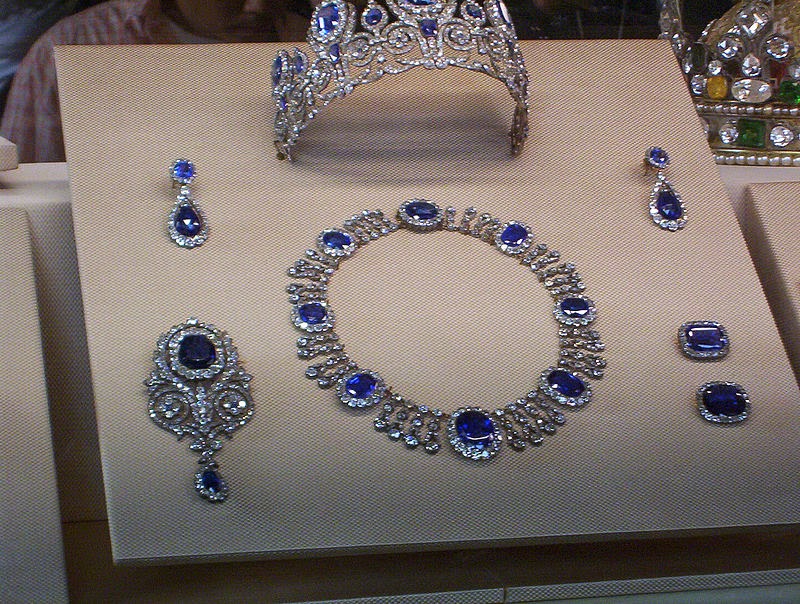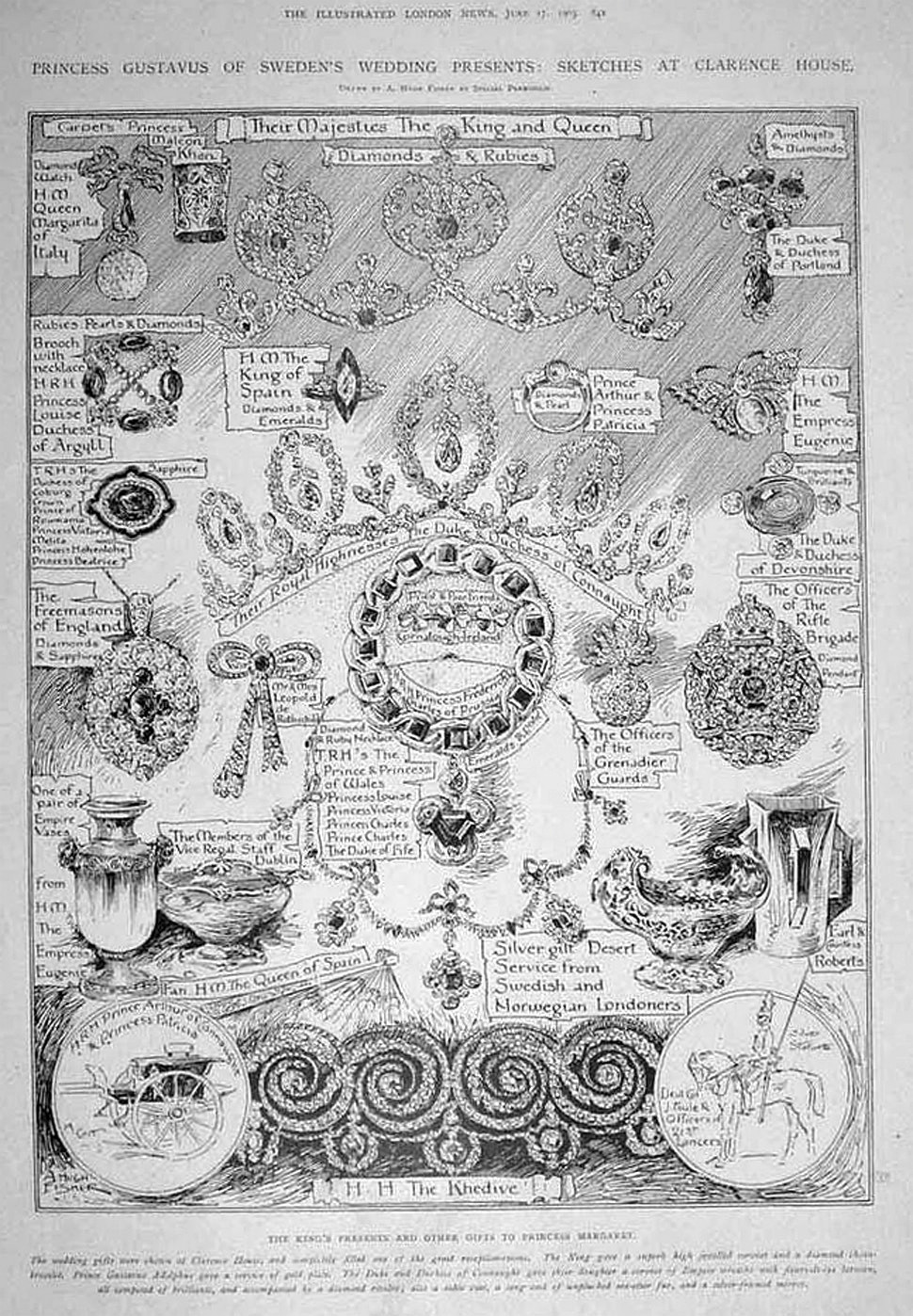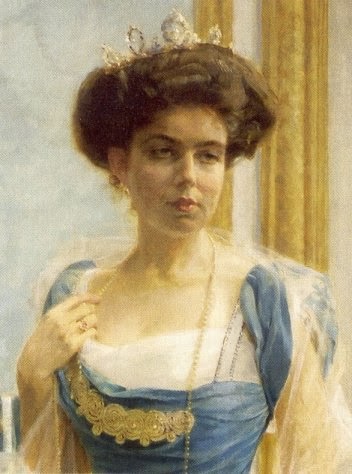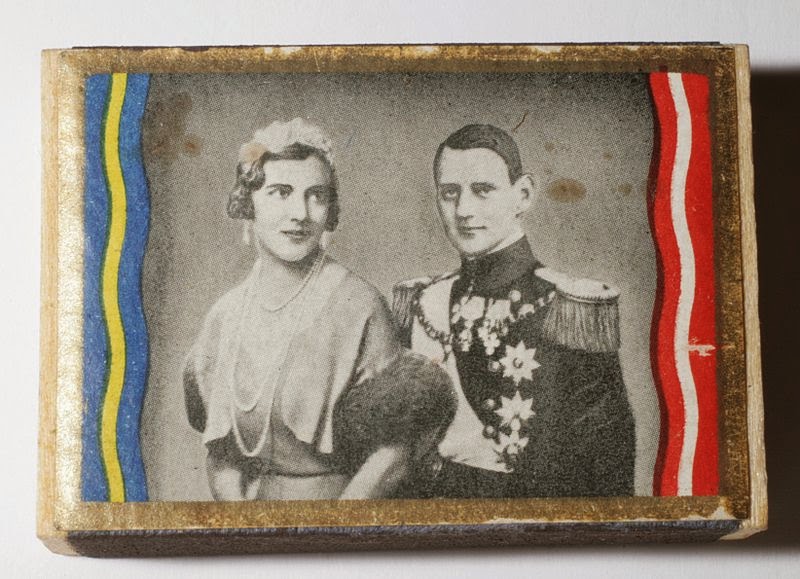In last week’s royal jewel news post, I referred to the golden wedding anniversary reception held for Constantine and Anne-Marie, the former king and queen of Greece, at the yacht club in Athens. Here’s a better look at the jewels worn by the couple and their royal guests at the celebration!
The Top Ten: Royal Sapphires
In my humble, jewel-loving opinion, September babies snagged one of the best birthstones around: the gorgeous sapphire. Sapphires come in many shades, but the beautiful traditional deep blue color is easily the most recognizable. Here are my picks for the top ten royal sapphires — be sure to weigh in with your lists in the comments below!
When Princess Caroline of Monaco attended the wedding of Crown Prince Frederik of Denmark in 2004, all eyes were on her tiara, an heirloom from the collection of her husband, the Prince of Hanover. But she also wore a set of Monegasque heirlooms that day: the cabochon sapphire and diamond demi-parure from the collection of her grandmother, Princess Charlotte. Charlotte wore the set, which was made by Cartier, at the wedding of Caroline’s parents, Rainier and Grace, in 1956. Caroline has been wearing the demi-parure — which includes a necklace, earrings, and a pair of brooches — since the 1970s.
When we explored the jewel collection of the late Diana, Princess of Wales last month, many of you were understandably drawn to the gorgeous sapphire and diamond clasp of one of her pearl choker necklaces. The clasp, originally a separate brooch, was a wedding present to Diana from the Queen Mother. Diana wore the piece during her tenure as Princess of Wales as well as after her divorce.
Marie-Adélaïde of Nassau may have had a short and tumultuous tenure as Luxembourg’s reigning grand duchess, but she left a gorgeous sparkling legacy in the family’s vaults: a diamond and sapphire tiara. Created in the late nineteenth-century, the tiara features leaf motifs surrounding a single large sapphire. The tiara can also be worn with an aquamarine in the place of the sapphire, but for me, the darker blue stone is the star of this sparkler.
On her wedding day in 1947, the future Queen Elizabeth II received a special gift from her beloved father, King George VI: a small suite of Victorian sapphire and diamond jewels. The necklace and earrings reportedly date from 1850, and the playwright Noel Coward called them “the largest sapphires [he had] ever seen.” In 1963, Elizabeth acquired a necklace formerly owned by Princess Louise of Belgium, had it set on a tiara frame, and used it to round out her sapphire set.
Crown Princess Mary of Denmark often wears a brooch made of diamonds, pearls, and a large faceted sapphire. It was reportedly one of the wedding gifts given to Princess Louise Margaret of Prussia when she married the Duke of Connaught (one of Queen Victoria’s sons) in 1879. The brooch made its way to Denmark via Louise Margaret’s granddaughter, Queen Ingrid. In 2006, Queen Margrethe gave the brooch to her daughter-in-law as a present in honor of the birth of her first child, Prince Christian.
One of the oldest sets of royal sapphires in Britain is the Cambridge sapphire parure, a set of jewelry that originally belonged to the Duchess of Cambridge, a daughter-in-law of King George III. The set was eventually inherited by another member of the Cambridge family: Queen Mary. In turn, she gave the sapphires to her daughter-in-law, Princess Marina. The set originally included a tiara, a necklace, a stomacher, and a set of brooches, but Queen Mary rearranged and augmented the jewels with additional pieces. The current wearer of the set is the Duchess of Kent; while the Kents auctioned off the parure’s original tiara, stomacher, and necklace, they have kept some of the pieces, including a second button-style tiara.
We’ve talked a bit about the classic sapphire and diamond brooch from the Queen’s collection — the Prince Albert Brooch — but for my money, the more intriguing sapphire brooch in HM’s collection is the sapphire, gold, and diamond brooch with Russian imperial roots. The brooch was acquired by Queen Mary from the collection of the late Marie Feodorovna in the 1930s. Mary left the brooch to Elizabeth II in 1953, but the Queen Mum kept the piece in her jewelry box until her death. The Queen didn’t wear the brooch in public for the first time until earlier this year, on a trip to Rome.

One of the most glorious sapphire sets around is the diamond and sapphire parure that belonged to Queen Marie-Amélie of France. The set, which includes a tiara, a necklace, earrings, and three brooches, was privately owned by Marie-Amélie, who was the wife of King Louis Philippe I. It’s been said that Marie-Amélie wasn’t the first royal owner of the sapphires — it’s possible that she bought them from Hortense de Beauharnais, the daughter of Empress Josephine. The sapphires stayed in the family even after Louis Phillipe lost his throne, and the mother of the current Count of Paris wore them regularly. But her husband ended up selling the parure — but happily, it was purchased by the Louvre Museum.
The glorious sapphire tiara worn by Queen Maxima at her husband’s inauguration in 2013 has a long history in the Dutch royal family. The family’s sapphire set is actually a “married” parure, with different sapphire jewels paired together even though they weren’t made as a matching set. The parure includes the tiara, a necklace, a set of bracelets, and a set of brooches. The Dutch royal ladies are inventive with their jewels, however, and they tend to wear parts of the parure separately and with additional sapphire and diamond pieces.
One of the grandest sapphire sets in any royal collection is the sapphire and diamond parure owned by the Swedish royal family. It’s possible that the set was given as a wedding present in 1806 to Princess Augusta of Bavaria by Napoleon Bonaparte, her groom’s stepfather. Augusta’s daughter, Josephine of Leuchtenberg, brought the set with her when she married the Swedish king, and the sapphires have been with the Swedes ever since. The set includes a massive diamond and sapphire tiara, a necklace, a pair of earrings, a brooch, and a set of hair ornaments.
Tiara Timeline: The Khedive of Egypt Tiara
Today I’m debuting a brand-new post series on the blog: Tiara Timelines, which follow the journey of various sparklers through royal families over their history. Our first tiara is one with a rich backstory and a romantic royal role: the Khedive of Egypt Tiara, a wedding gift that has become an official bridal diadem.
Wedding of Gustaf Adolf of Sweden and Margaret of Connaught, 1905
1905: Abbas II, the last Khedive of Egypt, commissions Cartier to make a wedding present for Princess Margaret of Connaught, a granddaughter of Queen Victoria. The gift is important not only because Abbas essentially rules the country under the imperial control of the British (and so he needs to give a British princess a good gift) but also because Margaret met and fell in love with her groom, Prince Gustaf Adolf of Sweden, during a trip to Cairo.

For the bride, Cartier makes a diamond tiara featuring abstract scrolling marguerite motifs, a clever nod to the bride’s nickname, Daisy. The piece is flexible and can also be worn as an ornament on a gown. Margaret doesn’t wear the tiara at her wedding, but it appears (as a corsage ornament) among an illustrated list of wedding presents published by the Illustrated London News (pictured above).

1909: Margaret, now Sweden’s crown princess, wears the tiara as an ornament on the bodice of her gown in a portrait painted by Axel Jungstedt. (The diamond tiara she wears in the portrait was another wedding gift, this time from her parents, the Duke and Duchess of Connaught.)
Crown princely family of Sweden, ca. 1913
1920: Margaret dies following an operation; she is only thirty-eight years old and is pregnant with her sixth child, who also dies. The Khedive tiara is inherited by her only daughter, Princess Ingrid, who has just turned ten.

1935: Ingrid marries Crown Prince Frederik of Denmark in Stockholm. A portrait of Ingrid wearing the Khedive tiara is featured on royal wedding souvenirs, including the matchbox pictured above. Like her mother, Ingrid does not wear a tiara at her wedding. With Ingrid’s marriage, the tiara moves from the Swedish royal family to the Danish royal family.
1948: Ingrid, now Queen of Denmark, loans the Khedive tiara to her cousin, Princess Margaretha of Denmark, for the inauguration of Queen Juliana of the Netherlands. Like Ingrid, Margaretha was born a Swedish princess and married a Danish prince. Margaretha was also a sister of Queen Astrid of the Belgians and Crown Princess Martha of Norway.
Portrait of Queen Ingrid, ca. 1950
ca. 1950: Ingrid wears the Khedive tiara for a photographic portrait. Although she now has access to numerous Danish tiaras as the nation’s queen, including the country’s crown jewels, she still wears her mother’s tiara on a regular basis.
Princess Margaretha of Sweden, 1958
1958: During the eighteenth-birthday celebrations of Ingrid’s eldest daughter, Margrethe, Ingrid loans the tiara to her niece, Princess Margaretha of Sweden. The daughter of Ingrid’s late brother, Prince Gustaf Adolf, Margaretha is a granddaughter and namesake of Margaret of Connaught.
Princess Margaretha of Denmark wears the tiara, 1960
1960: Ingrid again lends the tiara to Princess Margaretha of Denmark, who wears the sparkler during a banquet held in Brussels as a part of the festivities for the wedding of King Baudouin and Queen Fabiola of the Belgians.
Anne-Marie wears the tiara at her wedding, 1964
1964: Ingrid’s youngest daughter, Princess Anne-Marie of Denmark, wears the Khedive tiara at her wedding to King Constantine II of the Hellenes in Athens. She also wears the same Irish lace veil worn by Margaret of Connaught in 1905 and Queen Ingrid in 1935.
Margrethe wears the tiara at her wedding, 1967
1967: Princess Margrethe of Denmark, Ingrid’s eldest daughter and heir to the Danish throne, wears the Khedive tiara and Margaret of Connaught’s veil at her wedding to Count Henri de Laborde de Monpezat in Copenhagen.
Benedikte wears the tiara at her wedding, 1968
1968: The use of the Khedive tiara as an official family wedding diadem is cemented when Princess Benedikte of Denmark, Ingrid’s second daughter, wears the tiara and veil at her wedding to Prince Richard of Sayn-Wittgenstein-Berleburg.
Alexandra wears the tiara at her wedding, 1998
1998: A second generation of Ingrid’s family carries on the Khedive tiara wedding tradition. Ingrid loans the tiara and veil to her granddaughter (and Princess Benedikte’s elder daughter), Princess Alexandra of Sayn-Wittgenstein-Berleburg, who wears it to wed Count Jefferson von Pfiel und Klein-Ellguth.
Alexia wears the tiara at her wedding, 1999
1999: Ingrid loans to the tiara to another granddaughter, Princess Alexia of Greece and Denmark, who wears it with the Connaught veil at her wedding to Carlos Morales Quintana in London.
2000: Queen Ingrid dies at the age of ninety with her children and grandchildren at her bedside. The Khedive tiara is inherited by her youngest daughter, Anne-Marie, the former Queen of the Hellenes. (The Greek monarchy was abolished in the 1970s.) Anne-Marie is only the third owner of the tiara in its almost century-long history; the tiara moves to the collection of the former Greek royal family.
2001: Anne-Marie begins a trend of wearing the family’s wedding tiara at other royal weddings when she dons the sparkler at the wedding of Crown Prince Haakon and Crown Princess Mette-Marit of Norway. Anne-Marie has also by this point made an alteration to the tiara’s base so that the piece sits higher on the wearer’s head.
2004: At one of the pre-wedding galas held for her nephew, Crown Prince Frederik of Denmark, Anne-Marie wears the Khedive tiara in Copenhagen.
Nathalie wears the tiara at her wedding, 2010
2010: Princess Nathalie of Sayn-Wittgenstein-Berleburg borrows the Khedive tiara from her aunt for her wedding to Alexander Johannsmann; she also wears Margaret of Connaught’s veil. She’s the first family bride to wear the tiara with its taller base. The use of the tiara as a bridal diadem has so far been restricted to the female descendants of Queen Ingrid; the wives of her grandsons have worn different tiaras at their weddings. There are currently eight more descendants eligible to wear the tiara one day: Princess Theodora of Greece and Denmark, Princess Isabella of Denmark, Princess Josephine of Denmark, Princess Athena of Denmark, Arrietta Morales y de Grecia, Ana María Morales y de Grecia, Amelia Morales y de Grecia, and Princess Maria Olympia of Greece and Denmark.
2012: Anne-Marie brings the Khedive tiara back to Denmark again for Queen Margrethe II’s ruby jubilee, wearing it at a gala performance in her sister’s honor.
2012: Later the same year, Anne-Marie wears the tiara at a reception held the night before yet another royal wedding: the nuptials of Hereditary Grand Duke Guillaume and Hereditary Grand Duchess Stephanie of Luxembourg.
- « Previous Page
- 1
- …
- 134
- 135
- 136
- 137
- 138
- …
- 151
- Next Page »